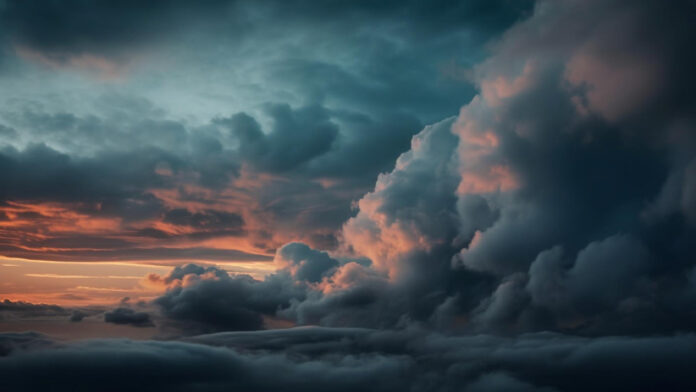In the vast canvas of the sky, clouds dance and paint ever-changing pictures, captivating our imaginations and inspiring poets and dreamers. In this article, we unravel the mysteries of clouds, delving into the science behind their formation, the diverse types that grace our skies, and the wondrous role they play in shaping our weather patterns. Join us on a journey through the heavens as we explore the enchanting world of clouds.
The Artistry of Cloud Formation
Condensation and Vapor: Clouds are born from the invisible water vapor in the atmosphere. As warm air rises, it cools and condenses into tiny water droplets or ice crystals, creating the visible formations we know as clouds.
The Role of Nuclei: Particles called cloud condensation nuclei (CCN) provide surfaces for water vapor to condense around. Dust, pollen, and even pollution can act as nuclei, influencing the formation and appearance of clouds.
A Symphony of Cloud Types
Cumulus Clouds: These puffy, cotton-like clouds are often associated with fair weather. Cumulus clouds form when warm air rises and moisture condenses into fluffy, white clouds scattered across the sky.
Cirrus Clouds: Delicate and wispy, cirrus clouds reside at high altitudes. Composed of ice crystals, they often signal changes in the weather and are known for their beautiful formations during sunrise and sunset.
Stratus Clouds: Low-hanging stratus clouds form in uniform layers, covering the sky like a blanket. They often bring overcast conditions and light precipitation, creating a serene but sometimes gloomy atmosphere.
The Play of Colors: Clouds in Sunrise and Sunset
Golden Hour Magic: During sunrise and sunset, clouds transform into a breathtaking palette of colors. The scattering of sunlight by cloud particles creates hues ranging from warm oranges to deep purples, adding a touch of magic to the sky.
Rayleigh Scattering: The phenomenon of Rayleigh scattering, where shorter wavelengths of light are scattered more than longer ones, contributes to the vivid colors seen during sunrise and sunset. This interaction with clouds creates stunning visual displays.
Clouds and Meteorological Clues
Cloudy Crystal Balls: Clouds serve as meteorological indicators, providing clues about impending weather changes. Low, thick clouds may signal rain, while high, thin clouds may indicate fair weather with a chance of atmospheric shifts.
Anvil Clouds and Storms: The iconic anvil-shaped clouds associated with thunderstorms, known as cumulonimbus incus, signify the powerful updrafts and turbulent weather within. They are a visual cue to the intensity of a storm.
Strange and Rare Cloud Formations
Lenticular Clouds: Resembling UFOs, lenticular clouds form near mountain ranges and are caused by the interaction of air currents with the terrain. Their saucer-like shapes make them a favorite among cloud enthusiasts.
Noctilucent Clouds: Noctilucent clouds, or “night-shining” clouds, appear in the upper atmosphere and are illuminated by sunlight after sunset. Their ethereal glow and electric-blue hues make them a rare and mesmerizing sight.
Cloud Gazing: A Skyward Pastime
Pareidolia in the Sky: Cloud gazing involves finding familiar shapes and figures in cloud formations. From animals to mythical creatures, the ever-changing canvas of the sky provides endless opportunities for imaginative interpretations.
Cloud Spotting Apps: Modern technology has made cloud identification more accessible. Apps and online resources allow enthusiasts to identify and learn about clouds, turning a casual pastime into an educational experience.
The Intricate Dance of Clouds in Art and Literature
Clouds in Art History: Clouds have been a recurring motif in art throughout history, symbolizing fleeting moments, dreams, and the sublime. From classical paintings to contemporary art, clouds continue to inspire creative expression.
Literary Reverie: Poets and writers often use clouds as metaphors for emotions, thoughts, and the transience of life. Clouds, with their ever-changing nature, serve as poignant symbols in literature, adding depth and meaning to poetic verses.
Capturing Clouds: Photography Tips
Chasing Clouds: Cloud photography offers a unique avenue for capturing the ever-changing sky. Tips for photographing clouds include paying attention to lighting, using polarizing filters, and experimenting with different angles.
Social Media Cloud Communities: The rise of social media has led to vibrant communities of cloud enthusiasts who share their captivating cloud photographs, turning the sky into a global canvas for artistic expression.
Conclusion: The Eternal Charm of Clouds
In conclusion, clouds are not just meteorological phenomena; they are enchanting works of art that grace our skies, telling stories of weather patterns, atmospheric interactions, and the beauty of nature. From their diverse types to the role they play in shaping our perceptions of the heavens, clouds continue to inspire awe and wonder. So, whether you find joy in cloud gazing, seek meteorological insights, or simply appreciate the poetry of the sky, the ever-changing tapestry of clouds invites us to look up, dream, and marvel at the celestial wonders above.

